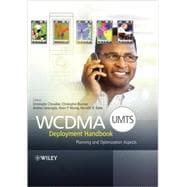
What is included with this book?
|
|||
|
|||
|
|||
|
|||
|
|||
|
|||
| 1.1 UMTS NETWORK TOPOLOGY. | |||
|
|||
|
|||
|
|||
| 1.2 WCDMA CONCEPTS. | |||
|
|||
|
|||
|
|||
| 1.3 WCDMA NETWORK DEPLOYMENT OPTIONS. | |||
| 1.4 THE EFFECTS OF VENDOR IMPLEMENTATION. | |||
|
|||
| 2.1 INTRODUCTION. | |||
| 2.2 OVERVIEW OF THE NETWORK DEPLOYMENT PROCESS. | |||
|
|||
|
|||
|
|||
| 2.3 LINK BUDGETS. | |||
|
|||
|
|||
|
|||
|
|||
| 2.4 NETWORK PLANNING TOOLS. | |||
|
|||
|
|||
| 2.5 INTERFERENCE CONSIDERATIONS DURING NETWORK PLANNING. | |||
| 2.6 TOPOLOGY PLANNING. | |||
| 2.7 PARAMETER SETTINGS AND OPTIMIZATION DURING NETWORK PLANNING. | |||
| 2.8 RF OPTIMIZATION. | |||
|
|||
|
|||
|
|||
|
|||
| 3.1 BASIC UMTS TRAFFIC ENGINEERING. | |||
|
|||
|
|||
|
|||
| 3.2 EFFECT OF VIDEO-TELEPHONY AND PS DATA ON TRAFFIC ENGINEERING. | |||
|
|||
|
|||
| 3.3 MULTI-SERVICE TRAFFIC ENGINEERING. | |||
|
|||
|
|||
| 3.4 CAPACITY PLANNING. | |||
|
|||
|
|||
|
|||
|
|||
|
|||
| 3.5 OPTIMIZING FOR CAPACITY. | |||
|
|||
|
|||
|
|||
|
|||
|
|||
|
|||
|
|||
|
|||
|
|||
|
|||
|
|||
|
|||
|
|||
|
|||
|
|||
|
|||
|
|||
|
|||
|
|||
|
|||
|
|||
|
|||
|
|||
|
|||
|
|||
|
|||
|
|||
|
|||
|
|||
|
|||
|
|||
| 5.1 KPI AND LAYERED OPTIMIZATION APPROACH. | |||
|
|||
| 5.2 VOICE SERVICE OPTIMIZATION. | |||
|
|||
|
|||
|
|||
|
|||
|
|||
|
|||
|
|||
|
|||
| 5.3 VIDEO TELEPHONY SERVICE OPTIMIZATION. | |||
|
|||
|
|||
|
|||
| 5.4 PS DATA SERVICE OPTIMIZATION. | |||
|
|||
|
|||
|
|||
|
|||
|
|||
|
|||
| 6.1 INTRODUCTION. | |||
| 6.2 INTER-SYSTEM BOUNDARY PLANNING. | |||
|
|||
|
|||
|
|||
| 6.3 INTER-SYSTEM TRANSITIONS IN CONNECTED MODE. | |||
|
|||
|
|||
|
|||
|
|||
|
|||
| 6.4 INTER-SYSTEM TRANSITIONS IN IDLE MODE. | |||
|
|||
|
|||
|
|||
|
|||
| 6.5 TEST SETUP FOR INTER-SYSTEM HANDOVER AND CELL RESELECTION PERFORMANCE ASSESSMENT. | |||
| 6.6 OPTIMIZING INTER-SYSTEM PARAMETERS. | |||
|
|||
|
|||
|
|||
| 6.7 ADDITIONAL INTER-SYSTEM PLANNING AND OPTIMIZATION ISSUES. | |||
|
|||
|
|||
|
|||
| 7.1 MOTIVATIONS FOR HSDPA. | |||
| 7.2 HSDPA CONCEPTS. | |||
|
|||
|
|||
|
|||
| 7.3 HSDPA PLANNING. | |||
|
|||
|
|||
|
|||
| 7.4 HSDPA OPERATION AND OPTIMIZATION. | |||
|
|||
|
|||
|
|||
|
|||
| 7.5 HSDPA KEY PERFORMANCE INDICATORS (KPI). | |||
|
|||
|
|||
|
|||
| 7.6 TEST SETUP. | |||
|
|||
| 8.1 INTRODUCTION. | |||
| 8.2 DESIGN APPROACH AND ECONOMIC CONSIDERATIONS. | |||
|
|||
|
|||
|
|||
| 8.3 COVERAGE PLANNING AND IMPACT ON CAPACITY. | |||
|
|||
|
|||
|
|||
|
|||
|
|||
|
|||
| 8.4 OPTIMIZING INDOOR SYSTEMS. | |||
|
|||
|
|||
|
|||
|
The New copy of this book will include any supplemental materials advertised. Please check the title of the book to determine if it should include any access cards, study guides, lab manuals, CDs, etc.
The Used, Rental and eBook copies of this book are not guaranteed to include any supplemental materials. Typically, only the book itself is included. This is true even if the title states it includes any access cards, study guides, lab manuals, CDs, etc.